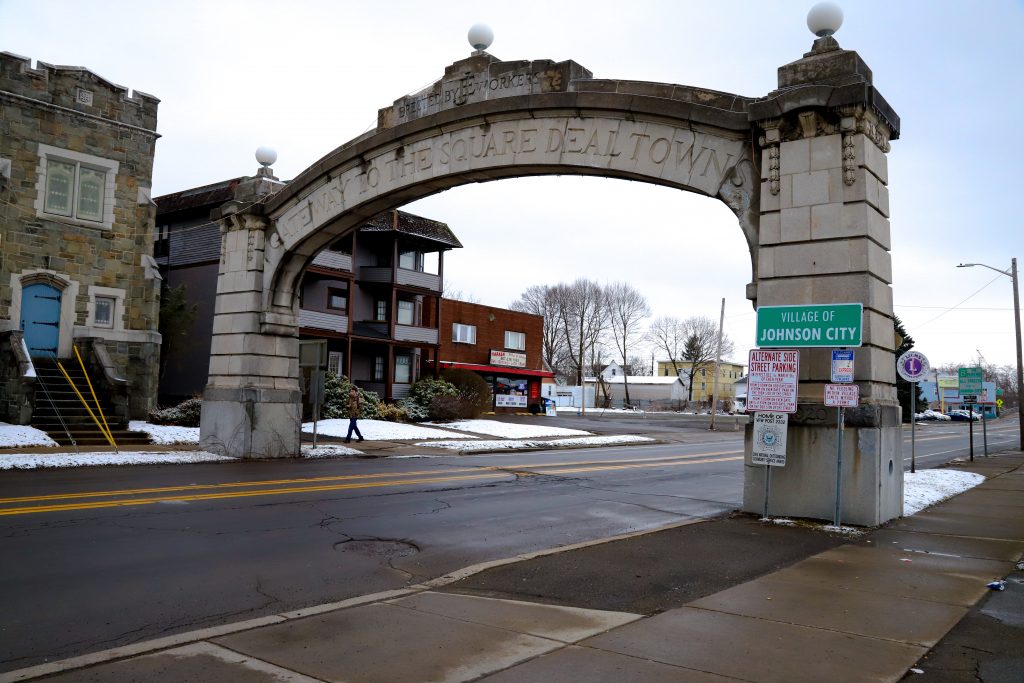Johnson City will receive $10 million from New York state to strengthen and reinvigorate its downtown area.
The money was received through the Downtown Revitalization Initiative (DRI), a program launched in 2016 and led by the New York Department of State. Localities submit applications to Regional Economic Development Councils (REDC) — economic representative bodies in each of New York state’s 10 regions — who then evaluate the pool and nominate one community to receive funding. The goal, according to the DRI website, is to “[transform] downtown neighborhoods into vibrant centers that offer a high quality of life and are magnets for redevelopment, business, job creation and economic and housing diversity.”
Johnson City’s application outlined existing developments, including the new 15-acre Binghamton University Health Sciences campus, the growth of UHS Wilson Medical Center and the transformation of the former Endicott-Johnson Victory building into over 140 new residential apartments. In the published vision statement, Johnson City anticipates a future economy grounded in health care and higher education, while “preserving and restoring its many historic assets and celebrating its ethnic and cultural diversity.”
Martin Meaney, the mayor of Johnson City, contextualized the new state funding within current progress.
“The investment that the state is making in awarding Johnson City the DRI will have a major impact,” Meaney wrote in an email. “Since the expansion of BU, there has been over $420 million invested in the downtown area. These were large projects, but [because of the DRI] the opportunity for smaller projects to come to fruition will occur sooner.”
New York Gov. Kathy Hochul announced the DRI grant, as well as other Southern Tier investments, in a Feb. 22 address at the Schorr Family Firehouse Stage in Johnson City — part of a statewide tour outlining her executive budget. Alongside her were local elected officials, including New York State Assemblywoman Donna Lupardo, who expressed gratitude for the budgeted proposals.
“The timing for [Johnson City] is ideal, as the downtown has reached a significant turning point,” Lupardo wrote in an email. “New energy and investments will accelerate plans for the Main Street area, increasing housing and foot traffic.”
Johnson City’s application listed “transformative project opportunities” that the grant funding would affect. This include remodeling historic buildings into residential and commercial spaces, supporting local restaurants and breweries, enhancing the walkability of Main Street, building more pedestrian and bike infrastructure, constructing more public parking and electric vehicle charging stations, and renovations of culturally significant properties. According to a press release from Hochul’s office, Johnson City’s ability to identify and quickly execute projects in need of funding contributed to the awarding of the DRI grant.
BU students responded positively to the revitalization efforts in downtown Johnson City. Chance Fiorisi, president of the College Democrats and a sophomore majoring in political science, expressed optimism about the future of the region.
“Hochul’s investment in Johnson City represents the Democratic Party’s priorities by supporting the economy from the ground up as opposed to the top down,” Fiorisi wrote in an email. “Places like Johnson City see the effects of post-industrial America [as] housing is scarce, and the economy is in shambles from industries leaving. I am happy to see more attention being spent here in the Southern Tier [because this] region is the next major hub of economic development for the state and more funding can only accelerate that statement into reality.”
Nathan Slisher, a sophomore majoring in environmental science, described the positive impacts planned projects can have.
“As someone living in Johnson City next year, I think that the plans to make the downtown more walkable and bikeable [are] a great idea,” Slisher said. “When cities build more people-friendly infrastructure, it encourages good health, both physical and mental. Reducing the need for cars is essential for building a sustainable future and will make Johnson City a better place to live.”
The last section of the DRI application contained letters of support from the broader community, including local officials, the private sector and educational leadership — including BU administration. A letter from BU President Harvey Stenger specifically praised the relationship between the University and Johnson City — a sentiment shared by Meaney.
“The students and the University have a major impact on our economy and are a major driving force,” Meaney wrote. “I feel that most BU students take pride in the community that they may call home for only four years, and I think that is awesome.”



